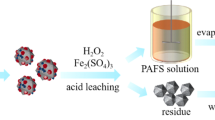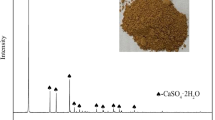Abstract
The most effective means to promote the sustainability of the circular economy is to recycle waste from various sources, such as industry and commerce. This study aimed to investigate alkali recovery from bauxite residue and the potential of iron recovery from dealkalized bauxite residue via the ferric sulfate dealkalization method. Under constant solid–liquid ratio and temperature conditions, the optimal dealkalization rate reaches 99.17% whren bauxite residue, FeSO4, and H2O2 in a proportion of 2:3:2. After undergoing 4 dealkalization cycles,, the Na+concentration in the supernatant reached 1800 mg L−1, and the alkaline recovery rate increased to 90% with the addition of 5 g L−1 CaO. Compared to acid leaching, this dealkalization method demonstrated superior long-term effectiveness in regulating alkalinity. The formation of Fe(OH)3 facilitated cementation the bauxite residue particles and considerably improved filtration performance through adsorption, bridging, and cross-linking mechanisms. Furthermore, the iron content of the dealkalized BR increased from 46.97% to 76.24%, meeting the China Standard for production grade iron ores (V grade). Approximately 8 tons of bauxite residue were estimated to be consumed, resulting in the generation of 4.64 tons of CaSO4. Thus, this sustainable method offers complete reutilization of bauxite residue, contributing to waste minimization efforts.







Similar content being viewed by others
References
Khairul MA, Zanganeh J, Moghtaderi B (2019) The composition, recycling and utilisation of Bayer red mud. Resour Conserv Recycl 141:483–498
Zhang M, Zhao M, Zhang G, Mannd D, Lumsden K, Tao M (2016) Durability of red mud-fly ash based geopolymer and leaching behavior of heavy metals in sulfuric acid solutions and deionized water. Constr Build Mater 124:373–382
Tian T, Zhang C, Zhu F, Yuan S, Guo Y, Xue S (2021) Effect of phosphogypsum on saline-alkalinity and aggregate stability of bauxite residue. TransNonferrous Metals Soc China 31:1484–1495
Zhao Y, Wang J, Luan Z, Peng X, Liang Z, Shi L (2009) Removal of phosphate from aqueous solution by red mud using a factorial design. J Hazard Mater 165:1193–1199
Borra CR, Blanpain B, Pontikes Y, Binnemans K, Van Gerven T (2015) Smelting of bauxite residue (red mud) in view of iron and selective rare earths recovery. J Sustain Metall 2:28–37
Deihimi N, Irannajad M, Rezai B (2018) Characterization studies of red mud modification processes as adsorbent for enhancing ferricyanide removal. J Environ Manage 206:266–275
Zhang DR, Chen HR, Xia JL, Nie ZY, Zhang RY, Pakostova E (2022) Efficient dealkalization of red mud and recovery of valuable metals by a sulfur-oxidizing bacterium. Front Microbiol 13:1–15
Guo Y, Ye Y, Zhu F, Xue R, Zhang X, Zhu M, Hartley W, Guo L, Xue S (2022) Improvements on physical conditions of bauxite residue following application of organic materials. J Environ Sci (China) 116:198–208
Xing Y, Zhou K, Zhang X, Lei Q, Peng C, Shi Y, Chen W (2021) Application of recycled ferric chloride for alkalinity regulation of bauxite residue. J Clean Prod 305:1–10
Ren X, Zhang X, Tuo P, Yang B, Chen J, Guo W, Ren J (2021) Neutralization of bauxite residue with high calcium content in abating pH rebound by using ferrous sulfate. Environ Sci Pollut Res 29:13167–13176
Liu W, Yang J, Xiao B (2009) Application of Bayer red mud for iron recovery and building material production from alumosilicate residues. J Hazard Mater 161:474–478
Hou D, Wu D, Wang X, Gao S, Yu R, Li M, Wang P, Wang Y (2021) Sustainable use of red mud in ultra-high performance concrete (UHPC): design and performance evaluation. Cement Concr Compos 115:1–15
Zhao H, Gou H (2021) Unfired bricks prepared with red mud and calcium sulfoaluminate cement: properties and environmental impact. J Build Eng 38:1–9
Ujaczki E, Feigl V, Molnar M, Cusack P, Curtin T, Courtney R, O’Donoghue L, Davris P, Hugi C, Evangelou MW, Balomenos E, Lenz M (2018) Re-using bauxite residues: benefits beyond (critical raw) material recovery. J Chem Technol Biotechnol 93:2498–2510
Mukiza E, Zhang L, Liu X, Zhang N (2019) Utilization of red mud in road base and subgrade materials: a review. Resour Conserv Recycl 141:187–199
Grudinsky P, Zinoveev D, Yurtaeva A, Kondratiev A, Dyubanov V, Petelin A (2021) Iron recovery from red mud using carbothermic roasting with addition of alkaline salts. J Sustain Metall 7:858–873
Yang W, Ma W, Li P, Liu Z, Yan H (2022) Alkali recovery of bauxite residue by calcification. Minerals 12:1–16
He Z, Zhou J, Tang J, Li C, Jiang J, Chen W, Zhu F, Xue S (2022) Accelerated alkalinity regulation and long-term dry-wet aging durability for bauxite residue remediated with biomass pyrolysis. J Environ Sci 111:220–228
Pepper RA, Couperthwaite SJ, Millar GJ (2016) Comprehensive examination of acid leaching behaviour of mineral phases from red mud: recovery of Fe, Al, Ti, and Si. Miner Eng 99:8–18
Power G, Gräfe M, Klauber C (2011) Bauxite residue issues: I. current management, disposal and storage practices. Hydrometallurgy 108:33–45
Li X, Zhou Z, Wang Y, Zhou Q, Qi T, Liu G, Peng Z (2020) Enrichment and separation of iron minerals in gibbsitic bauxite residue based on reductive bayer digestion. Trans Nonferrous Metals Soc China 30:1980–1990
Liu X, Han Y, He F, Gao P, Yuan S (2021) Characteristic, hazard and iron recovery technology of red mud—a critical review. J Hazard Mater 420:1–13
Cardenia C, Balomenos E, Panias D (2018) Iron recovery from bauxite residue through reductive roasting and wet magnetic separation. J Sustain Metall 5:9–19
Paradis M, Duchesne J, Lamontagne A, Isabel D (2007) Long-term neutralisation potential of red mud bauxite with brine amendment for the neutralisation of acidic mine tailings. Appl Geochem 22:2326–2333
Kong X, Li M, Xue S, Hartley W, Chen C, Wu C, Li X, Li Y (2017) Acid transformation of bauxite residue: conversion of its alkaline characteristics. J Hazard Mater 324:382–390
Gräfe M, Klauber C (2011) Bauxite residue issues: IV. Old obstacles and new pathways for in situ residue bioremediation. Hydrometallurgy 108:46–59
Whittington BI, Fletcher BL, Talbot C (1998) The effect of reaction conditions on the composition of desilication product DSP formed under simulated bayer conditions. Hydrometallurgy 49:1–22
Kishida M, Harato T, Tokoro C, Owada S (2017) In situ remediation of bauxite residue by sulfuric acid leaching and bipolar-membrane electrodialysis. Hydrometallurgy 170:58–67
Cusack PB, Healy MG, Ryan PC, Burke IT, Donoghue LMT, Ujaczki É, Courtney R (2018) Enhancement of bauxite residue as a low-cost adsorbent for phosphorus in aqueous solution, using seawater and gypsum treatments. J Clean Prod 179:217–224
Xiaobo Z, Tao W, Wang L (2020) Experiment and Kinetics of dealkalization from red mud by leaching with titanium dioxide waste acid. Bull Chin Ceramic Soc 39:3918–3923
Liqun X, Tingan Z, Guozh L, Weiguang Z, Xiaofeng Z, Yanxiu W (2017) Experimental study on carbonization process of diaspore Bayer calcified red mud. J Mater Metall 16:68–72
Wu Y, Jiang Y, Jiang J, Chen L, Qin X, William H, Xue S (2022) Conversion of alkaline characteristics of bauxite residue by mechanical activated pretreatment: Implications for its dealkalization. J Environ Manage 305:1–11
Xue S, Wu Y, Li Y, Kong X, Zhu F, William H, Li X, Ye Y (2019) Industrial wastes applications for alkalinity regulation in bauxite residue: a comprehensive review. J Central South Univ 26:268–288
Ma Y, He J, Ma R (2005) Fe behaviores in acid solution. Hunan nonferrous metal 21:36–39
Lyu F, Hu Y, Wang L, Sun W (2021) Dealkalization processes of bauxite residue: a comprehensive review. J Hazard Mater 403:1–17
Liao J, Jiang J, Xue S, Qingyu C, Wu H, Manikandan R, Hartley W, Huang L (2018) A novel acid-producing fungus isolated from bauxite residue: the potential to reduce the alkalinity. Geomicrobiol J 35:840–847
Zhang Y, Yu X (2011) Research on alumina recovery from sodium hydrate alumino-silicate by hydro-treatment. Mining Metall Eng 31:76–81
Zhang G, Li S, Zhang X, Wang Z (2012) Study on the effect of fresh water washing on dealkalization of red mud from Bayer process. J Qingdao Technol Univ 33:59–62
Hanahan C, McConchie D, Pohl J, Creelman R, Clark M, Stocksiek C (2004) Chemistry of seawater neutralisation of bauxite refinery residues (red mud). Environ Eng Sci 21:125–138
Shu K, Sasaki K (2022) Occurrence of steel converter slag and its high value-added conversion for environmental restoration in China: a review. J Clean Prod 373:1–24
Acknowledgements
The authors would like to thank all authors for their support of this research effort.
Funding
This study was supported by the National Natural Science Foundation of China (Grant No. 52060011).
Author information
Authors and Affiliations
Corresponding authors
Ethics declarations
Conflict of interest
On behalf of all authors, the corresponding authorstates that there is no conflict of interest.
Additional information
Publisher's Note
Springer Nature remains neutral with regard to jurisdictional claims in published maps and institutional affiliations.
Supplementary Information
Below is the link to the electronic supplementary material.
10163_2023_1815_MOESM1_ESM.doc
Supplementary file1 (DOC 73 KB) Table S2 Comparison of BR comprehensive utilization and dealkalization method. Table S2 Explanation of abbreviations.
Rights and permissions
Springer Nature or its licensor (e.g. a society or other partner) holds exclusive rights to this article under a publishing agreement with the author(s) or other rightsholder(s); author self-archiving of the accepted manuscript version of this article is solely governed by the terms of such publishing agreement and applicable law.
About this article
Cite this article
Xie, X., Chen, S., Cui, X. et al. Alkali recovery from bauxite residue via ferric sulfate dealkalization and convert dealkalization residue into a secondary iron resource. J Mater Cycles Waste Manag 26, 213–221 (2024). https://doi.org/10.1007/s10163-023-01815-4
Received:
Accepted:
Published:
Issue Date:
DOI: https://doi.org/10.1007/s10163-023-01815-4




